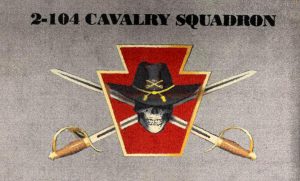All-Source Intelligence Analyst (35F)
Official Job Title: All-Source Intelligence Analyst (35F)
Name of Organization: Headquarters/Headquarters Troop (H/HT), 2-104th Cavalry Squadron, 56th Stryker Brigade Combat Team (SBCT), 28th Infantry Division, PAARNG
Job Date: March 2013 – March 2018


To qualify as an All-Source Intelligence Analyst (35F) I enlisted in the PA Army National Guard, completed 10 weeks of Basic Combat training in Fort Jackson, SC, where I earned an Army Achievement Medal, and 20 weeks of Advanced Individual Training for 35F in Fort Huachuca, AZ.
Between 2013 and 2018 I was assigned to the S2 section of Headquarters/Headquarters troop of the Pennsylvania Army National Guard in Reading, PA. The S2 section of the H/HT troop element resides in the lowest possible echelon of tactical intelligence in the Army. This means it is “closest to the action”. As echelons increase, more intelligence products are funneled up through the Chain of Command (CoC) and consolidated by other analysts into new deliverables.
As a 35F I worked through the Intelligence Preparation of the Battlefield (IPB) and the Military Decision-Making Process (MDMP). Intelligence items collected from ground are provided to the S2 and its job is to process the information into a database, make predictions, and create specific actionable products to give presentation on to the Unit Commander so he or she may make important decisions on how to proceed.
The database software Intelligence Analysts use is the Distributed Common Ground System-Army (DCGS-A). It is “a system-of-systems that supports the intelligence warfighting function” and “consists of both software and hardware. Hardware includes user laptops and desktops, fixed, portable and vehicle-mounted servers, and ground stations to receive, share and store collected intelligence.”
I was certified on DCGS-A annually. The course focused on the implementation of all of its features, some of which include: creating link-diagrams of various entities and their relationships to one another; collecting information on significant events or people from multiple databases and plotting this information to real-time digital maps; and diagnosing certain issues with servers and channels of communication.
In 2014, in a four-day segment of Intelligence Analyst school, I participated in a Field Training Exercise (FTX) during which I used DCGS-A in a wargame simulation to create deliverable intelligence products through my understanding of IPB which recommended friendly Courses of Action (COAs) and anticipated enemy COAs. At the conclusion of every shift I debriefed leadership and my rotating replacement.
In 2015, I supported Operation Iron Angel and earned a Certificate of Achievement for the Joint Task Force – World Meeting of Families when the Pope, Jorge Mario Bergoglio, visited Philadelphia. I coordinated intelligence between the Philadelphia Police Department, other domestic law enforcement agencies, and the National Guard.
During Annual Training in 2015, I earned a second Army Achievement Medal in part due to my tasking at subsidiary unit. I defined and advised the subsidiary unit’s Commander on Priority Intelligence Requirements (PIRs). PIRs are information that a Commander needs to know in order to make a decision or achieve a desired effect. I worked in the unit’s Tactical Operations Center (TOC) creating analog products and digital products on the DCGS-A system in exercise of the aforementioned intelligence processes.
In 2016, during a training designed to develop core warfighting competencies in soldiers, I was employed in my role and also as a Radio Telephone Operator (RTO). In this added capacity I managed intelligence communications between four subsidiary units.
As part of my contractual obligation, I drilled, at minimum, one weekend a month and two weeks in the summer.
In March of 2018 I received an Honorable Discharge.
My experience as an All-Source Intelligence Analyst deals heavily with the Management Information Systems curriculum at Temple University and with business intelligence and analytics disciplines. Some key concepts include:
- Processing design, improvement, and flow of information (MIS2101 Information Systems in Organizations)
- Accessing databases (MIS 2502 Data Analytics)
- Creating effective data-driven visuals
- Building networks of information
- Presenting data-driven information to stakeholders

